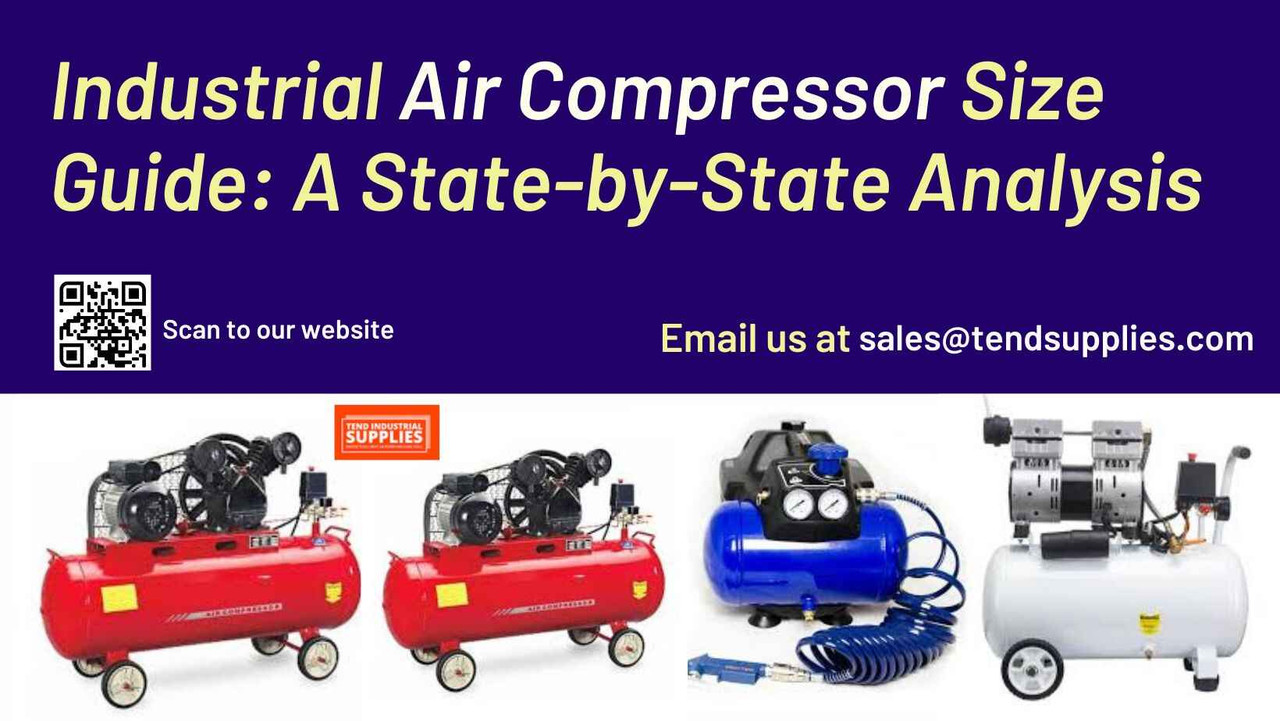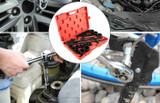Industrial Air Compressor Size Guide: A State-by-State Analysis
Key Takeaways
- CFM (Cubic Feet per Minute) requirements vary by tool and application.
- Temperature and humidity affect compressor performance differently by region.
- Local regulations may impact compressor selection and installation.
- Proper sizing ensures efficiency and tool performance.
- Regional factors influence maintenance requirements.
Introduction
Selecting the right size air compressor is crucial for optimal performance of pneumatic tools and equipment. Finding the right industrial air compressor requires understanding both the needs of the job and the specific regulatory or environmental conditions in your state. This guide provides a state-by-state analysis to help you make informed choices tailored to local industry standards, climate demands, and usage requirements. Whether you’re outfitting a workshop, factory floor, or large-scale manufacturing facility, knowing the optimal compressor size for your location can maximize efficiency and reduce maintenance issues. Dive into this comprehensive analysis to find the perfect compressor solution that meets both operational and regional needs.
This comprehensive guide analyzes requirements across different states, considering regional factors like climate, typical applications, and local regulations.
Understanding Air Compressor Specifications
Essential Measurements
- CFM (Cubic Feet per Minute)
- PSI (Pounds per Square Inch)
- Tank Size (Gallons)
- Horsepower (HP)
- Duty Cycle
CFM Requirements by Tool Type
| Tool Type | Required CFM | Recommended PSI |
| Impact Wrench | 4-8 CFM | 90-100 PSI |
| Air Sander | 6-9 CFM | 90-100 PSI |
| Paint Sprayer | 12-15 CFM | 40-60 PSI |
| Air Hammer | 2-4 CFM | 90-100 PSI |
| Die Grinder | 4-6 CFM | 90-100 PSI |
Regional Analysis
Northeast Region
The northeastern United States, encompassing New York, New Jersey, Massachusetts, Connecticut, Rhode Island, Pennsylvania, and other New England states, presents unique challenges for air compressor operation. This region's combination of high humidity levels and significant seasonal temperature variations requires careful consideration in compressor selection. Urban areas in these states often have strict noise ordinances, making sound reduction a critical factor. Many facilities in this region operate in confined spaces, particularly in older industrial buildings and urban workshops, necessitating careful consideration of compressor footprint and ventilation requirements.
Facilities in the Northeast should prioritize robust moisture separation systems and consider larger tank sizes (minimum 60 gallons) to handle the humid conditions effectively. Sound-dampening features are essential, particularly in densely populated areas where noise regulations are strictly enforced. Additionally, the region's cold winters necessitate proper insulation and heating considerations for compressor rooms.
Northeast Region (NY, NJ, MA, CT) Summary
- Higher humidity considerations
- Indoor space limitations
- Noise regulations in urban areas
Recommended Specifications:
- Minimum 60-gallon tank for professional use
- Moisture separation systems
- Sound dampening features
Southeast Region
Throughout Florida, Georgia, South Carolina, North Carolina, Alabama, Mississippi, and other southeastern states, air compressor systems face challenges from consistently high humidity and elevated temperatures. This region's subtropical climate creates unique demands on air compression systems, particularly regarding moisture control and cooling requirements. Coastal areas in these states face additional challenges from salt air exposure, which can accelerate corrosion.
Enhanced moisture control systems are not optional but essential for southeastern facilities. We recommend comprehensive moisture removal systems, including cyclone separators, coalescing filters, and refrigerated air dryers. Tank sizing should account for increased condensation, and materials should be selected with corrosion resistance in mind. Cooling systems must be oversized compared to northern regions, and ventilation requirements are more stringent.
Southeast Region (FL, GA, SC, NC) Summary
- High humidity challenges
- Extended cooling requirements
- Corrosion prevention needed
Recommended Specifications:
- Enhanced moisture control
- Thermal protection
- Rust-resistant components
Midwest Region
The Midwest, including Illinois, Michigan, Ohio, Indiana, Wisconsin, Minnesota, and surrounding states, experiences some of the most dramatic temperature variations in the country. This region's industrial diversity, from automotive manufacturing to agricultural processing, requires versatile compression solutions. The extreme temperature swings from summer to winter create unique challenges for system maintenance and operation.
Midwest facilities need compressor systems designed for temperature flexibility, with enhanced cold-weather starting capabilities and summer cooling capacity. We recommend systems with synthetic lubricants rated for extreme temperatures and variable speed drives to handle seasonal demand changes efficiently. Tank sizing should account for increased condensation during humidity swings, and installation should include considerations for both heating and cooling requirements
Midwest Region (IL, MI, OH, IN) Summary
- Temperature fluctuations
- Varied industrial applications
- Seasonal considerations
Recommended Specifications:
- All-weather capability
- Flexible capacity options
- Robust thermal protection
Western Region
The western United States, including California, Oregon, Washington, Nevada, and other Pacific states, presents a diverse range of operating conditions, from coastal to high-altitude locations. This region's strict environmental regulations, particularly in California, require careful attention to emissions and energy efficiency. Seismic considerations also play a crucial role in installation requirements.
Western facilities must prioritize CARB compliance where applicable and consider altitude adjustments for proper operation. We recommend systems with advanced control capabilities to maintain efficiency across varying conditions. Seismic mounting and restraint systems are essential, particularly in zones with high earthquake risk.
Western Region (CA, OR, WA) Summary
- Strict emissions regulations
- Diverse altitude requirements
- Seismic considerations
Recommended Specifications:
- CARB compliance where required
- Altitude-adjusted performance
- Seismic mounting options
Sizing Guidelines by Application
Manufacturing facilities represent the most demanding air compression requirements in most regions. These operations typically require sustained high-volume air delivery for multiple simultaneous tools and processes. A manufacturing facility should plan for at least 50 CFM continuous delivery, with many operations requiring significantly more based on specific methods. Large tank sizes, typically 120 gallons or more, buffer peak demand periods. Rotary screw compressors are often the best choice for these applications, offering the reliability and efficiency needed for continuous operation.
Automotive repair and maintenance facilities face different challenges. They require reliable air delivery for multiple pneumatic tools but often with more intermittent usage patterns. These operations typically need between 25 and 40 CFM of continuous delivery capacity. Two-stage piston compressors with 60-80 gallon tanks provide a good balance of capacity and cost-effectiveness. The intermittent nature of automotive work means the system should be sized to handle brief periods of high demand while maintaining consistent pressure for precision tools.
Construction sites present unique challenges due to their temporary nature and varying power availability. Portable air compression systems must deliver between 15 and 30 CFM, depending on the tools used. While smaller tank sizes (30-60 gallons) are more practical for mobility, the system must maintain adequate pressure for heavy-duty tools like pneumatic nailers and impact wrenches. Special consideration should be given to environmental protection and durability in outdoor conditions.
Home workshops and smaller professional shops require careful sizing to balance capability with cost-effectiveness. These installations typically need 5-15 CFM delivery capacity, suitable for running most common air tools individually or using small combinations of tools simultaneously. Single-stage piston compressors with 20-30 gallon tanks perform well for this application level. While duty cycles are lower, the system should still be sized with some overhead capacity to handle occasional peak demands.
Sizing Guidelines by Application Summary
Manufacturing Facilities
- Required CFM: 50+ CFM
- Minimum Tank Size: 120 gallons
- Recommended Type: Rotary screw
- Duty Cycle: 100%
Automotive Shops
- Required CFM: 25-40 CFM
- Minimum Tank Size: 60-80 gallons
- Recommended Type: Two-stage piston
- Duty Cycle: 75%+
Construction Sites
- Required CFM: 15-30 CFM
- Minimum Tank Size: 30-60 gallons
- Recommended Type: Portable piston
- Duty Cycle: 50%+
Home Workshops
- Required CFM: 5-15 CFM
- Minimum Tank Size: 20-30 gallons
- Recommended Type: Single-stage piston
- Duty Cycle: 25-50%
Climate Considerations
Temperature Effects
- Cold Climate Adjustments:
- Additional tank drainage
- Cold-start capabilities
- Synthetic lubricants
- Hot Climate Requirements:
- Enhanced cooling systems
- Temperature monitoring
- Regular maintenance intervals
Humidity Management
- Automatic drain valves
- Multi-stage filtration
- Refrigerated air dryers
- Desiccant systems
Regulatory Compliance
State-Specific Requirements
- Pressure vessel certifications
- Noise ordinances
- Environmental regulations
- Installation permits
Safety Standards
- OSHA Requirements
- State-specific workplace safety
- Local building codes
- Environmental regulations
Sizing Calculator Guide
Use this formula to determine basic CFM requirements:
- List all tools to be used simultaneously
- Add their individual CFM requirements
- Add 30% for system losses and future expansion
- Consider duty cycle requirements
Example Calculation:
Total Tool CFM + (Total Tool CFM × 0.30) = Required CFM
Frequently asked Question
1. How do I know if my compressor is large enough?
Your compressor should provide at least 1.5 times the CFM requirement of your highest-demand tool.
2. Does altitude affect compressor performance?
Yes, higher altitudes require larger compressors due to decreased air density.
3. How often should I drain my compressor tank?
Daily in humid regions, weekly in dry regions, and always after each use in cold climates.
4. What size compressor do I need for painting?
For professional painting, choose a compressor delivering at least 12-15 CFM at 90 PSI.
5. Should I oversize my compressor?
A 30% capacity buffer is recommended for optimal performance and future expansion.
Related Articles
- Understanding the Right Size of Air Compressor for Your Pneumatic Air Tools
- The Best Air Compressors for Powering Tools in New Jersey's Cold Weather
- Energy Efficiency in Air Compressors: What to Look For
- Air Compressor Noise Reduction Techniques
- Decoding CFM: Why It Matters in Air Compressor Performance
Conclusion
Don't risk equipment failure or inefficient operation with an improperly sized air compressor. Contact Tend Industrial Supplies today for expert guidance on selecting the perfect air compressor for your specific needs and location.
Contact us:
- Email: sales@tendsupplies.com
- Website:www.tendsupplies.com
- Browse our air compressor selection
Let our experts help you make the right choice for your region and application. Your satisfaction and productivity are our top priorities.






